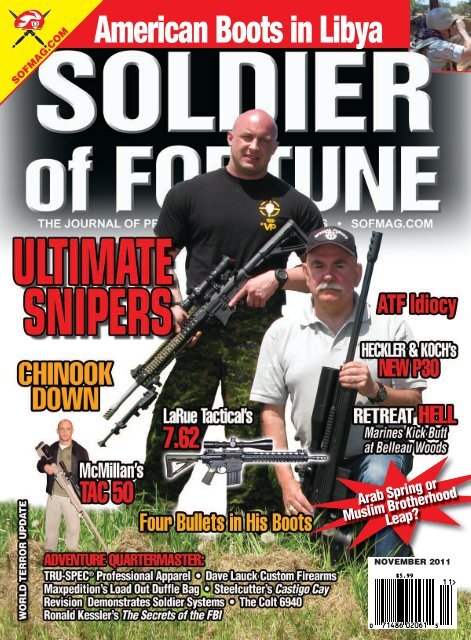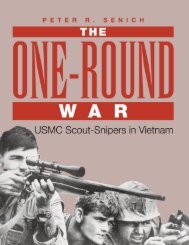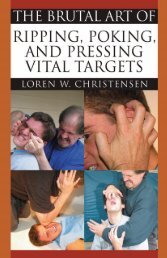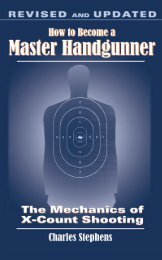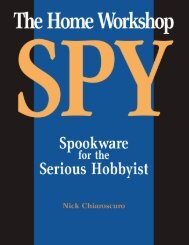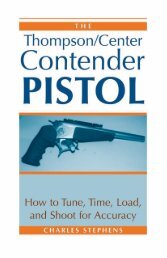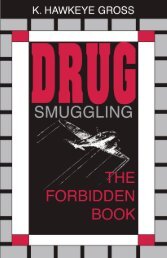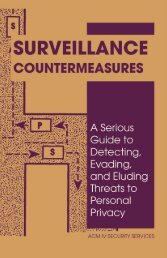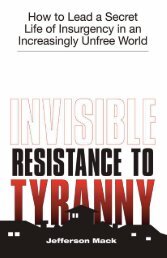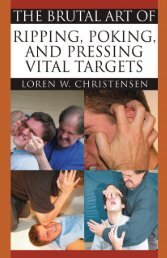Create successful ePaper yourself
Turn your PDF publications into a flip-book with our unique Google optimized e-Paper software.
SOFMAG.COM<br />
American Boots in Libya<br />
Arab Spring or<br />
Muslim Brotherhood<br />
Leap<br />
NOVEMBER 2011<br />
$5.99<br />
11<br />
0 71486 02061 5
By Mark Gongea<br />
A U.S. Army sniper team, armed with an<br />
M107 Barrett .50 cal. semi-auto rifle, prepares<br />
to engage a distant Taliban fighter in<br />
Afghanistan.<br />
42 SOLDIER OF FORTUNE SUPPORT OUR TROOPS
In recent conflicts in Iraq and Afghanistan, the<br />
majority <strong>of</strong> U.S. and Coalition casualties<br />
have come from improvised explosives devices<br />
(IEDs). The insurgents figured out early<br />
on that they could not fight the U.S. military in gun<br />
battles, so they relied on proven guerrilla tactics.<br />
But the terrorists’ asymmetric advantage lasted only<br />
until the Coalition forces came up with counter tactics.<br />
One important game changer was the rapid improvement<br />
in weapons, equipment and employment<br />
<strong>of</strong> snipers. As the United States and its allies improved<br />
the technology <strong>of</strong> sniping and, perhaps more<br />
importantly, the use <strong>of</strong> snipers, success stories <strong>of</strong> astounding<br />
feats—shots at ranges previously thought<br />
impossible, under difficult conditions and sometimes<br />
through unlikely objects, such as brick walls—<br />
started coming back from the front.<br />
Continued on page 44<br />
SOFMAG.COM NOVEMBER 2011 43
Ultimate Snipers Continued from page 43<br />
Former Canadian sniper Robert Furlong takes<br />
aim with a Barrett .50 caliber sniper rifle. In<br />
2002 he set a world record for a .50-cal. kill,<br />
dropping a Taliban leader at 2700 yards in<br />
Afghanistan.<br />
In 1993, Paladin advanced<br />
the training <strong>of</strong> snipers with<br />
the publication <strong>of</strong> The Ultimate<br />
Sniper by Major John<br />
Plaster (revised and updated<br />
in 2006). That book was<br />
followed by two Ultimate<br />
Sniper videos, the last one<br />
released in 1996. In view <strong>of</strong><br />
developments on the battlefields<br />
<strong>of</strong> Afghanistan and Iraq, it was<br />
clearly time to take another look at<br />
snipers, their weapons, their technology,<br />
and their employment.<br />
There could be no better person to<br />
take on this task than John Plaster, the<br />
author <strong>of</strong> the Ultimate Sniper books and<br />
videos and Special Forces combat veteran.<br />
To help him with this modern update<br />
on today’s snipers, Plaster enlisted<br />
the help <strong>of</strong> Canadian Robert Furlong,<br />
who holds the world record at more than<br />
2,700 yards for a confirmed kill with a<br />
.50 caliber rifle; U.S. Army First Sergeant<br />
James Gilliland, who holds the<br />
record for the longest conventional<br />
sniper rifle kill in Iraq; and former U.S.<br />
Marine sniper Steve Reichert, who<br />
achieved the longest .50 caliber kill in<br />
Iraq and famously fired through a brick<br />
wall to eliminate a machine gun team<br />
endangering his Marine company.<br />
Whenever you have the opportunity to<br />
be around the top people in any field for<br />
even a brief moment, you are indeed fortunate.<br />
I had the chance to spend several<br />
days watching and listening to the premier<br />
instructor <strong>of</strong> snipers and three <strong>of</strong><br />
the top snipers in the world demonstrate<br />
the state <strong>of</strong> today’s art <strong>of</strong> sniping. The<br />
Ultimate Sniper III video shoot promised<br />
to be a revealing look into this<br />
world.<br />
• • •<br />
Spring usually arrives late in northern<br />
Wisconsin, but this year it had been exceptionally<br />
tardy. When the Paladin<br />
video crew arrived in early June to film<br />
the third installment in the Ultimate<br />
Sniper video series in Iron River, Wisconsin—the<br />
home <strong>of</strong> Major John Plaster—the<br />
snows from early May had<br />
barely melted away. The lingering cool<br />
temperatures and moisture had left the<br />
area green and lush and perfect for<br />
shooting a sniping video.<br />
The Paladin crew consisted <strong>of</strong> publisher<br />
Peder Lund, video director Matt<br />
Doyle, cameraman Brad Efting, and me,<br />
Continued on page 46<br />
44 SOLDIER OF FORTUNE SUPPORT OUR TROOPS
Ultimate Snipers Continued from page 44<br />
a freelance video editor from Canada,<br />
who was participating in my first Paladin<br />
video shoot. We arrived on Thursday<br />
afternoon and were scheduled to<br />
meet Steve Reichert at the airport in Duluth,<br />
Minnesota, for the 54-mile drive to<br />
Iron River. At the airport we learned that<br />
Reichert’s flight into Duluth had been<br />
delayed and he would not be arriving<br />
until very late that night. So we drove to<br />
Iron River, confident that the Marine<br />
sniper could find his way to town. Neither<br />
Doyle nor I had met John Plaster<br />
before, and we were curious about Paladin’s<br />
best-selling author. The first thing<br />
we learned about the retired U.S. Army<br />
major who spent three tours in Vietnam<br />
with MACV–SOG was that he doesn’t<br />
waste time with casual talk.<br />
RECONNAISSANCE<br />
“Let’s go and check all the locations,”<br />
he told us as soon as the introductions<br />
were completed. “Here are a list, a map,<br />
satellite snapshots, and characteristics <strong>of</strong><br />
each place,” he announced, as he passed<br />
out copies <strong>of</strong> his files to each <strong>of</strong> us. We<br />
were all impressed by Plaster’s preparations.<br />
He had delivered the detailed outline<br />
weeks ago, and<br />
the handout included<br />
maps, list <strong>of</strong><br />
locations with all<br />
data we’d ever need,<br />
satellite pictures<br />
with measurements,<br />
a summary script for<br />
each scene, plus detailed<br />
descriptions<br />
<strong>of</strong> locations and instructors.<br />
“Great,” I thought<br />
to myself, “we just<br />
have to set up the<br />
gear and push the<br />
record button.” That<br />
turned out to be not<br />
quite true.<br />
“We’re going to<br />
use my truck,” Plaster<br />
instructed. “It’s<br />
better to ride together<br />
so we can<br />
talk about the<br />
shoot.”<br />
All five <strong>of</strong> us<br />
crammed into the<br />
SUV and were soon<br />
Rob Furlong with a<br />
McMillan TAC-50,<br />
similar to the TAC-<br />
50 he used to execute<br />
the 2,430<br />
meter (2,657 yards)<br />
shot in Afghanistan<br />
during Operation<br />
Anaconda in March<br />
M 12:12 2002. PM Page 1<br />
THE WORLD IS FULL OF COMPROMISES.<br />
MCMILLAN BELIEVES YOUR RIFLE SHOULDN'T BE ONE OF THEM.<br />
LEGACY<br />
DYNASTY ®<br />
PRESTIGE <br />
PRODIGY <br />
HERITAGE<br />
OUTDOORSMAN<br />
TACTICAL HUNTER<br />
TAC -308 .308 WIN<br />
TAC -300 .300 WIN MAG<br />
TAC -338 .338 LAPUA MAG<br />
TAC -50 50 BMG<br />
M1A<br />
Custom Collection Hunting Rifles • Tactical Rifles • Stocks • Ammunition<br />
Rings & Bases • Training • Accessories • Custom Actions<br />
© 623-582-0536 • www.mcmillanusa.com<br />
46 SOLDIER OF FORTUNE SUPPORT OUR TROOPS
acing to the first location, the “241”<br />
point, as Plaster had named it on his<br />
hand-drawn map. During the 10-mile<br />
drive, deep in the Chequamegon National<br />
Forest, we had time to admire the<br />
wildness <strong>of</strong> this place. There were only<br />
woods as far as the eye could see.<br />
“We are in Bayfield County—20,000<br />
people and not a single stoplight in the<br />
whole county,” Plaster told us as he<br />
pulled over on the side road. “This is<br />
241, where we’re going to fire in extreme-range<br />
conditions, over 1,000<br />
yards.”<br />
Everything around was charred, the<br />
aftermath <strong>of</strong> a massive fire. “It was a<br />
controlled burn,” Plaster explained as<br />
we looked around at the terrain, made a<br />
few notes about staging shots, and<br />
asked a few questions before heading<br />
out for the next location, “Wyoming,”<br />
he called it.<br />
“The most important<br />
objective for<br />
this shoot is to find<br />
safe locations,<br />
where we can send rounds at long distance.<br />
I personally selected all <strong>of</strong> them. I<br />
got lucky with my friends; a lot <strong>of</strong> people<br />
were <strong>of</strong>fering their help to make this<br />
video a success,” <strong>of</strong>fered Plaster.<br />
In the next hour, we saw the last two<br />
locations, “1800” and “The Sheriff’s,”<br />
plus two backup locations in case <strong>of</strong> bad<br />
weather. All were perfect.<br />
“READY, AIM, SHOOT!”<br />
After a very successful first day, we<br />
were eagerly looking forward to Friday,<br />
when we would meet the three decorated<br />
combat snipers. Day two started<br />
with a strong handshake delivered by a<br />
very strong Marine. Steve Reichert had<br />
arrived late in the night, driving from<br />
Minneapolis, but he appeared rested and<br />
ready to start filming.<br />
We loaded up and headed to “1800”<br />
for the first scenes to be shot with Reichert.<br />
As Steve was getting his sniper<br />
rifle ready, John Plaster took snap shots<br />
with a Savage TRR-SR .17 cal Hornady<br />
Magnum Rimfire rifle, and explained<br />
the unexpected choice <strong>of</strong> rifle and<br />
ammo.<br />
“This ammo is not expensive, but it is<br />
high quality, perfect for snap-shooting<br />
and positional shooting, where<br />
a lot <strong>of</strong> expensive<br />
match-grade ammo<br />
could be consumed.<br />
Use a rim-fire to get<br />
the desired results<br />
before you start training with a combat<br />
rifle.”<br />
Though he is only 31, Reichert has a<br />
long history as a sniper. It started when<br />
he was in the sixth grade and bought<br />
John Plaster’s Ultimate Sniper book<br />
from Paladin Press and read it cover to<br />
cover, over and over. Hiding in a tree<br />
house, he would pretend that he was a<br />
Marine sniper in combat and use the<br />
book’s information to decide what to do<br />
in various scenarios.<br />
“Soon after that,” Reichert said, “I<br />
bought the Ultimate Sniper video with<br />
all the money I could save from my<br />
chores, especially shoveling snow. It<br />
was at that time I decided what path I<br />
would follow: join the Marines and become<br />
a sniper.”<br />
Later that afternoon, Jim Gilliland and<br />
Rob Furlong joined us, and the discus-<br />
Continued on page 48<br />
The new Paladin Press instructional DVD features four world-class snipers: (L–R), Canadian world record .50 cal. shooter, Robert Furlong;<br />
U.S. Army Special Forces SOG combat veteran, John L. Plaster; the USMC sniper with the longest recorded kill in Iraq, Steven<br />
Reichert; and U.S. Army Airborne Ranger sniper, Jim Gilliland, who achieved the longest 7.62 mm kill in Iraq.<br />
SOFMAG.COM NOVEMBER 2011 47
Ultimate Snipers Continued from page 47<br />
sion among the snipers soon turned to<br />
the differences between pr<strong>of</strong>essional<br />
soldiers and insurgents.<br />
“The enemy soldiers have no morality,<br />
no ethic. They have never heard <strong>of</strong><br />
Geneva Conventions, and even if they<br />
had, they will never comply<br />
with its content,” remarked<br />
Reichert <strong>of</strong> his<br />
observations from Iraq.<br />
Gilliland, who was an<br />
instructor at the U.S. Army<br />
Sniper School and whose<br />
“Shadow Sniper Team”<br />
was credited in a USA<br />
Today article with more<br />
than 200 kills, shared two<br />
<strong>of</strong> his combat stories to illustrate<br />
how the enemy<br />
isn’t bound by the same<br />
rules as Western forces.<br />
“They can operate in<br />
mosques, churches, and<br />
hospitals, and we can’t really<br />
go in there. They can<br />
even dress up as women.<br />
Late one afternoon in Ramadi,<br />
one <strong>of</strong> the shooters<br />
and I were observing an<br />
area, and we noticed a<br />
woman dressed in a complete<br />
burqa come out <strong>of</strong> a<br />
side street and very near to<br />
a known IED location. Her<br />
movements were very erratic,<br />
a lot <strong>of</strong> looking<br />
around, and she just did<br />
not fit in. Basically, she<br />
was out a lot later than we<br />
were used to women being<br />
out. So we watched this individual<br />
for about 20 minutes<br />
until she turned and<br />
walked back into the alleyway.<br />
The two <strong>of</strong> us talked<br />
back and forth, and Harry<br />
and I decided this was something we really<br />
needed to pay attention to. Then the<br />
individual came back out, looked around<br />
a time or two, and then immediately<br />
JOIN US ON FACEBOOK<br />
<strong>Soldier</strong> <strong>of</strong> <strong>Fortune</strong> Magazine<br />
bent over where the IED hole was and<br />
started brushing material out <strong>of</strong> the way.<br />
“That gave us what we needed to positively<br />
identify hostile intent. So I got on<br />
the spotter scope, and Harry jumped on<br />
the rifle and with a 700-yard one-round<br />
"Send it”! Acting<br />
as spotter for<br />
USMC sniper vet<br />
Steven<br />
Reichert, veteran<br />
Green Beret John<br />
Plaster focuses on<br />
a distant target.<br />
kill laid this individual over. We were<br />
very nervous about this kill because we<br />
didn’t know what the reaction was going<br />
to be since the target was a woman. The<br />
two <strong>of</strong> us talked it over and spent the<br />
night doing some reports to preempt<br />
what was might happen.<br />
“The next morning when the sun<br />
started coming up, we both noticed that<br />
the woman was still lying there, which<br />
was absolutely not normal. Usually the<br />
bodies were policed up during the night<br />
and as a general rule buried before the<br />
sun came up the next day. But this individual<br />
was still out there. I got back on<br />
the spotting scope and looked down at<br />
the body. The burqa face cover had<br />
flipped up, and underneath was a large<br />
Wahabbi (fundamentalist) beard. It was<br />
actually a man who had come in and<br />
started digging a hole with the intention<br />
<strong>of</strong> planting an IED.<br />
“Another time,” Gilliland<br />
continued, “we had an individual,<br />
a male, who had<br />
been shooting at one <strong>of</strong> our<br />
patrols, put a child, four or<br />
five years old, on his shoulders<br />
to give him a piggyback<br />
ride. But the man was<br />
still walking around with<br />
his weapon, thinking that<br />
no one would engage him<br />
because <strong>of</strong> the child. Fortunately<br />
for the troops who<br />
were on the ground, we had<br />
a sniper team right there. It<br />
was a 200-meter shot, very<br />
low risk, so we put three<br />
rapid rounds into the individual<br />
to take him out. The<br />
child ran <strong>of</strong>f unharmed.<br />
“These two scenarios we<br />
just talked about give you<br />
an idea <strong>of</strong> what you might<br />
see on today’s battlefields.<br />
You are not going to fight<br />
against a uniformed individual;<br />
you are not going to<br />
fight against a soldier or a<br />
warrior. You are going to<br />
fight an indigenous person<br />
using the things they have<br />
and know, and they are<br />
willing to do anything to<br />
win.”<br />
Gilliland holds the record<br />
for the longest sniper kill<br />
recorded for a 7.62mm rifle<br />
in Iraq, shooting into the<br />
fourth floor <strong>of</strong> a hospital in<br />
Ramadi at 1,250 meters to eliminate an<br />
enemy sniper who’d just killed an<br />
American. He took this difficult shot<br />
with the scope’s turret set for maximum<br />
elevation and with the scope’s mil dot<br />
reticule held over an additional 2 mils,<br />
or approximately 12 feet <strong>of</strong> “Kentucky<br />
windage.”<br />
“It was a one-in-a-million shot that I<br />
do not expect to be able to duplicate,”<br />
added Gilliland modestly.<br />
EXTREME RANGE FIRING<br />
On our second day <strong>of</strong> shooting we<br />
moved to “241,” where we would be<br />
48 SOLDIER OF FORTUNE SUPPORT OUR TROOPS
filming heavy rifle live fire at extreme<br />
range. We noted that it was cooler than<br />
the previous day, but temperature was <strong>of</strong><br />
little concern to the snipers.<br />
“The wind is a sniper’s biggest challenge,”<br />
Plaster explained. “A wind<br />
gauge only tells you the wind where you<br />
are; it cannot tell how<br />
the wind is behaving<br />
where your target is,<br />
and it cannot give you<br />
an estimate for the wind<br />
along the projected trajectory<br />
<strong>of</strong> the bullet.<br />
You cannot predict the<br />
wind’s direction and velocity<br />
unless you see its<br />
effect on trees or other<br />
natural elements.”<br />
Reichert elaborated.<br />
“Snipers these days<br />
carry a lot <strong>of</strong> technology<br />
with them. In the past<br />
you might have had a<br />
thermometer, a compass,<br />
your data sheet<br />
and log book, and that<br />
would allow you to<br />
make an educated decision<br />
on a firing solution<br />
with what you had in<br />
front <strong>of</strong> you. Today,<br />
shooters have a weather<br />
station that will give<br />
barometric pressure,<br />
temperature, and wind<br />
speed. That’s great, but<br />
it’s what you do with<br />
the information that counts, and that’s<br />
Sniper Jim<br />
Gilliland steps<br />
upon his spotter's<br />
back to gain<br />
enough clearance<br />
to take a shot in<br />
Ramadi, Iraq.<br />
Gilliland's team<br />
was credited with<br />
more than 200<br />
enemy kills.<br />
where PDAs [personal digital assistants]<br />
come into play.<br />
“I can plug all the environmental data<br />
into the PDA to produce a firing solution<br />
that will get me a lot closer to the<br />
target on that first round. When you are<br />
shooting at extreme distance, figuring<br />
out the trajectory isn’t necessarily the<br />
hard part—figuring out the wind is.<br />
With a PDA you can enter multiple<br />
winds in different zones. If I have a<br />
wind going one way here and a wind<br />
500 meters away going a different<br />
way—wind going in different directions<br />
all the way to the target—I can plug<br />
those into the PDA to get a firing solution<br />
to get the first round on target with<br />
a lot greater efficiency and accuracy.”<br />
Reichert assembled his .50-caliber<br />
rifle, an impressive M107 Barrett, which<br />
was being used for the first rounds at<br />
more than 1,000 yards. The ammunition<br />
was Hornady AMAX .50 BMG match<br />
with a 1.050 ballistic coefficient and<br />
premium propellants. Rob Furlong<br />
would be assisting Reichert.<br />
Furlong explained his role. “When<br />
shooting at extreme range, it is very important<br />
to have a good spotter. The spotter<br />
will look through his scope and will<br />
watch the arc <strong>of</strong> bullet trajectory as it<br />
transits mirage or rippling heat waves.<br />
The bullet makes a ‘swirl,’ and that is<br />
what a spotter carefully observes. He<br />
can also see how and where the wind<br />
will change the trajectory, the wind intensity<br />
and direction, and therefore he<br />
will be able to make corrections and assist<br />
the sniper in making the adjustments.<br />
The best spotter is a former<br />
sniper, with years <strong>of</strong> experience in<br />
watching the bullet in the air.”<br />
“How can you see that swirl, Rob<br />
How does it look” someone asked.<br />
Rob smiled. “It is like in the Matrix<br />
movie. Remember when everything is in<br />
slow motion and you can see trajectory<br />
<strong>of</strong> the bullet in the air Also, another important<br />
element to consider is the<br />
‘splash’ the bullet makes when it hits either<br />
the ground or another surface.”<br />
The cameraman set one <strong>of</strong> the cameras,<br />
which was positioned close to the<br />
target, to record and then backed away<br />
to a safe distance. We were around some<br />
<strong>of</strong> the most precise shooters in the<br />
world, but we were dealing with deadly<br />
rounds so all safety precautions were<br />
observed.<br />
Furlong looked over the valley to the<br />
target. “In extreme-range shooting, it is<br />
too far to estimate by eyesight. I’m curious<br />
to see how it is going be here in the<br />
valley. The wind is going be challenging,<br />
as always.”<br />
From his prone position, Reichert interjected:<br />
“At extreme range, your aim is<br />
to put enough rounds out there that<br />
you’re bound to hit something.”<br />
The .50 caliber slammed into Reichert’s<br />
shoulder, and the bullet travelled<br />
the 1,000 yards, its swirl and splash relaying<br />
precious information to his spotter,<br />
Furlong.<br />
“Two mil on vertical, 1 mil right,<br />
Steve.”<br />
“OK, Rob, ready to fire!”<br />
“Send it!”<br />
“Windage is good, 1 mil down.”<br />
“Up!”<br />
“Send it!”<br />
Another bullet swirled through the air.<br />
Continued on page 50<br />
A new novel by Matt Bracken,<br />
author <strong>of</strong> the “Enemies” trilogy.<br />
Former Marine sniper Dan Kilmer<br />
lives outside a corrupt, third-world<br />
America, until a short-fuse rescue<br />
mission forces him to return to<br />
Florida under the <strong>of</strong>ficial radar.<br />
Available at Amazon and on Kindle.<br />
To read 100 pages <strong>of</strong> Castigo Cay<br />
or to order signed copies, go to:<br />
www.EnemiesForeignAndDomestic.com<br />
SOFMAG.COM NOVEMBER 2011 49
Ultimate Snipers Continued from page 49<br />
This time, Rob watched the impact with<br />
the steel target.<br />
“Hit!”<br />
Lying nearby behind a Savage .338<br />
Lapua Magnum equipped with a Millett<br />
LRS 6–25x56 scope, John Plaster placed<br />
a first-round hit into a target at 744<br />
yards. Adjusting his scope, Plaster repeated<br />
that at 1000 yards with another<br />
first-round hit. Then, firing the same<br />
rifle, Furlong cranked up the elevation<br />
and hit another steel target, well beyond<br />
1,000 yards. That was less than half the<br />
distance <strong>of</strong> his longest confirmed sniper<br />
kill in Afghanistan (2,700 yards), which<br />
remains the world record .50 caliber<br />
shot. In 2009, a British soldier, Corporal<br />
Craig Harrison, exceeded Furlong’s shot<br />
by a mere 100 feet—but that was with a<br />
.338 Lapua Magnum, not a .50 caliber.<br />
While waiting to fire, Furlong told us<br />
about his confirmed kill in the rugged<br />
mountain terrain <strong>of</strong> Afghanistan in<br />
March 2002, while he was attached to a<br />
U.S. Special Forces team.<br />
“A group <strong>of</strong> three al-Qaeda fighters<br />
were moving into a mountainside position<br />
in Shah-i-Kot valley at about 9,000<br />
feet above sea level. They were walking,<br />
maybe thinking it was their lucky day,<br />
but . . . it wasn’t,” he emphasized.<br />
Furlong described the conditions that<br />
surrounded his shot. Previously, he had<br />
run out <strong>of</strong> Canadian ammo and was firing<br />
U.S. ammo, which<br />
was “hotter,” which<br />
means it traveled<br />
flatter and farther.<br />
Approximately 1 1/2 miles (2,700 yards)<br />
away, he knew that his long-range sniper<br />
weapon (LRSW), a .50-caliber McMillan<br />
TAC-50 long-range sniper rifle and ammunition<br />
loaded with 750-grain Hornady<br />
A-MAX very-low-drag bullets, had a<br />
maximum effective range <strong>of</strong> 2,190 yards.<br />
Taking advantage <strong>of</strong> an old sniper trick,<br />
Furlong laid out his ammo in the sun to<br />
warm it, hoping to coax even more distance<br />
from the rounds.<br />
Furlong also had to adjust for elevation<br />
drop, as well as the three crosswinds<br />
swirling at the time. “I was maxed out on<br />
both elevation drop and windage,” he remembered,<br />
“so I halved the scope and<br />
led the target four mils for windage and<br />
four mils for elevation. I took aim at a<br />
Taliban fighter carrying an RPK machine<br />
gun. The first round missed the target; the<br />
second hit the knapsack on his back; the<br />
third struck the target’s torso, killing<br />
him.”<br />
With a muzzle speed <strong>of</strong> 823 m/s<br />
(2,700 feet per second), each shot<br />
reached the target approximately four<br />
seconds after being fired. “A .50 round<br />
is devastating. If a .50-caliber round hits<br />
you, you’re not going to live to tell<br />
about it. I knew I hit him, and that was<br />
part <strong>of</strong> my job, to eliminate the enemy<br />
threat,” Rob concluded and assumed his<br />
position to fire the first round for the<br />
camera.<br />
The new sniping DVD is dedicated to<br />
two sniper-qualified posthumous Medal<br />
<strong>of</strong> Honor recipients, U.S. Army Special<br />
Forces Staff Sergeant Robert J.<br />
Miller (shown), and U.S. Navy SEAL<br />
Lieutenant Michael J. Murphy.<br />
50 SOLDIER OF FORTUNE SUPPORT OUR TROOPS


